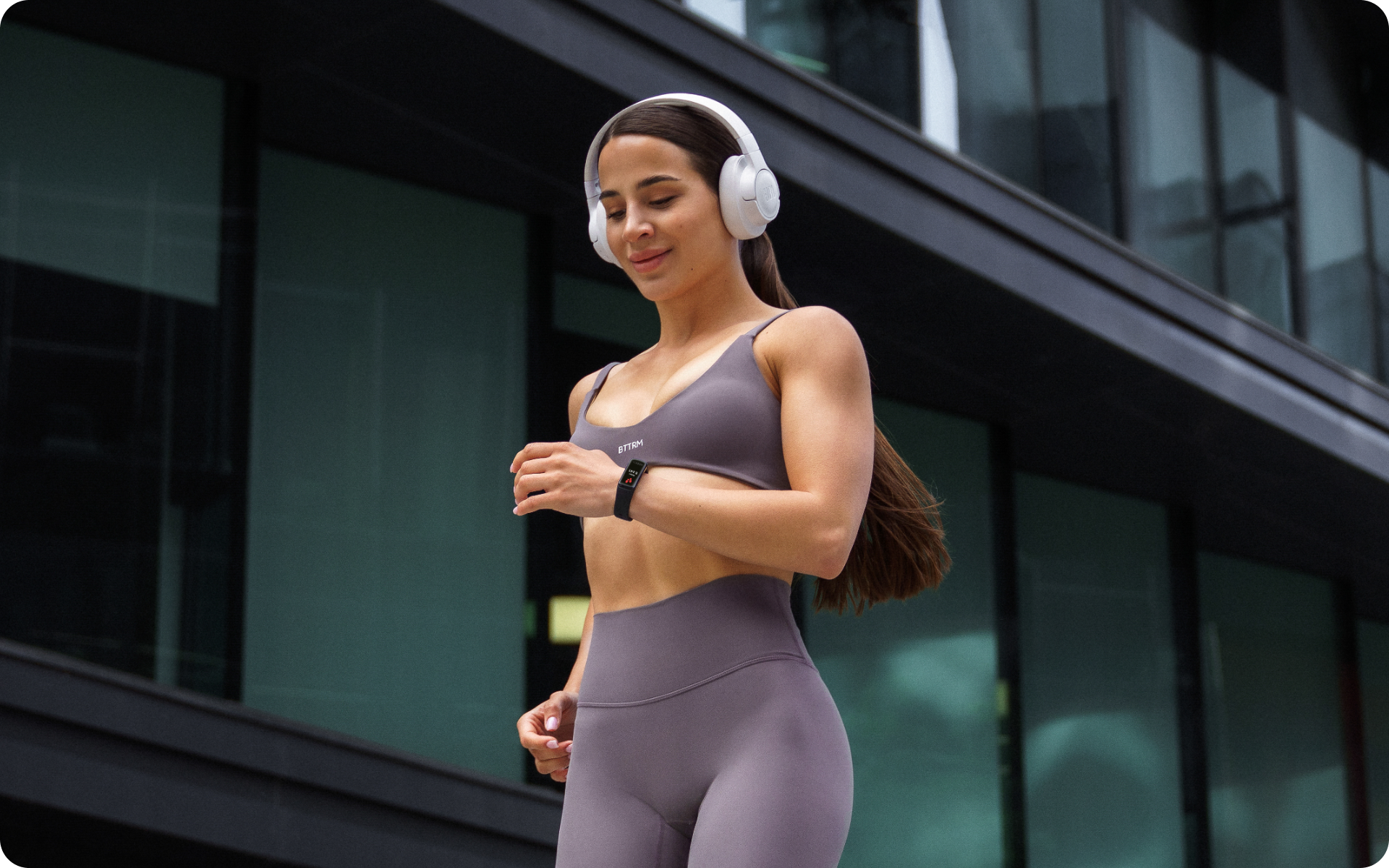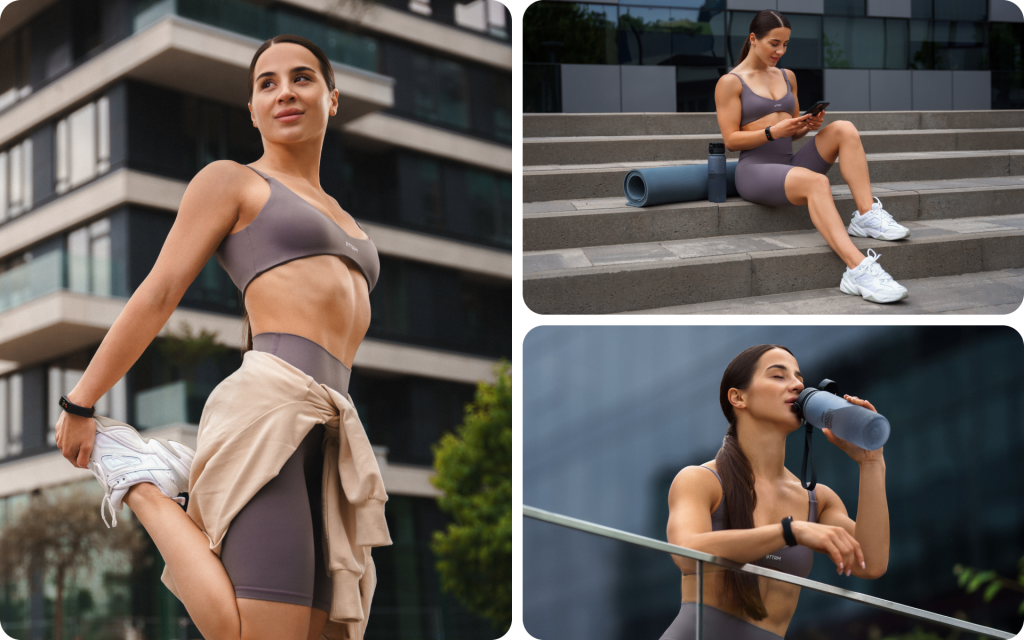Walking is a low-impact activity where at least one foot is always in contact with the ground. This makes it gentler on your joints and suitable for a wide range of fitness levels. Jogging, on the other hand, involves a faster pace where both feet briefly leave the ground with each stride, which creates more impact on your body.
While jogging typically burns more calories and challenges your cardiovascular system harder due to its higher intensity, not all walking is created equal. Power walking, uphill walking, indoor walking exercises, and weighted walking are some advanced techniques that push the limits of what we think walking can do.
Depending on the pace, incline, and effort, some walking strategies may come surprisingly close to the calorie burn and fitness benefits of jogging.
Here’s what you need to know.
What Walking Workout Is More Powerful Than Jogging?
Whether a walking workout is “more powerful” than jogging depends entirely on how you define “powerful” and what your goals are.
If “powerful” means burning the most calories or achieving the highest cardiovascular intensity in the shortest time, jogging generally has the edge. Its higher intensity naturally leads to greater calorie burn and cardio benefits (1).
However, if “powerful” is about joint health, injury prevention, or engaging more muscle groups, certain walking workouts such as Nordic walking, incline walking, or weighted walking can surpass jogging. These techniques offer unique benefits, such as reduced joint impact, improved posture, and targeted muscle engagement, which jogging doesn’t always provide (2).
So, while no walking workout universally outperforms jogging in every aspect, some can be more effective, depending on your specific fitness goals.
1. Power Walking
Power walking pushes walking to its limits, with speeds typically ranging from 4 to 5 mph. It involves exaggerated arm swings and a consistent, brisk pace. At the top end, power walking burns almost as many calories as jogging at a similar speed. For example, a person who weighs 150 pounds may burn roughly 175 calories during 30 minutes of power walking at 4.5 mph, comparable to jogging lightly (3).
The key benefit? Lower impact. Power walking is easier on your knees, hips, and ankles as there’s always one foot on the ground. For those who are prone to joint issues, this makes it a safer alternative to jogging while still delivering solid cardiovascular and calorie-burning results (2). That being said, it’s difficult to sustain high speeds for long, which makes jogging the more efficient choice for some.
2. Nordic Walking
Nordic walking incorporates poles, much like cross-country skiing. These poles engage your upper body muscles, including your arms, shoulders, chest, and back. This added effort increases calorie burn by as much as 20-40% compared to regular walking (4). Nordic walking also reduces strain on your lower joints, redistributing the workload to your upper body (5).
Compared to jogging, Nordic walking excels in building total-body strength and improving posture while still being joint-friendly. However, as it’s slower than jogging, it’s less effective for building cardio endurance at high intensities. It’s a great middle-ground for people who are looking to diversify their movement patterns — especially useful in indoor walking routines during colder months or rainy days.
BetterMe is your fast-track ticket to long-lasting weight loss! Tailor your fitness journey and maximize your results with just a couple of swipes!
3. Weighted Walking
Walking with a weighted vest adds resistance to your workout, turning your body into a portable weight machine. The extra load demands more effort from your muscles, particularly your legs and core. Studies have shown that wearing a weight vest equivalent to 10% of your body weight can increase your calorie burn by 8-12% (6).
What’s fascinating is that weighted walking can strengthen muscles while still being low-impact. It can mimic the muscle-building benefits of jogging without the same force on your joints (7) But there’s a caveat – weighted walking isn’t ideal for beginners or those with prior injuries. You need to condition your body to handle added weight safely.
4. Incline Walking
Walking on an incline, whether on a treadmill or a hill, significantly increases the intensity. Inclines force your body to recruit additional muscles, particularly those in your glutes, hamstrings, and calves (8). Even at slower speeds, walking on a steep incline (5-15%) can burn calories at a rate equivalent to moderate jogging (9).
Incline walking’s main advantage lies in its accessibility and adaptability. You can adjust the incline to match your fitness level, which makes it a scalable workout option. It also spares your joints from the pounding impact of jogging (8). However, it doesn’t quite reach the overall cardio intensity that sustained jogging can provide.
Read more: Walking With Weights: Benefits, Risks And Tips
Is Walking More Effective than Running?
Walking Pros and Cons
Pros
- Low Impact: Gentle on joints, which makes it suitable for people with arthritis, injuries, or mobility issues (2).
- Low Injury Risk: Lower impact reduces the chance of overuse injuries, such as shin splints or runner’s knee (2).
- Accessible: Can be done almost anywhere and at any fitness level – no need for extensive warm-ups or specialized skills.
- Sustainable: Easier to maintain for longer periods, allowing for more consistent daily movement.
- Supports Recovery: Great for active recovery days as it promotes blood flow without straining the body (10).
Cons
- Lower Calorie Burn: Walking typically burns fewer calories per minute than running.
- Less Intense Cardio: Doesn’t elevate heart rate as much as running, which may limit improvements in cardiovascular endurance.
- Time-Consuming: To achieve similar calorie burn or fitness results to running, you’ll need to walk longer distances.
Running Pros and Cons
Pros
- High Calorie Burn: Running burns significantly more calories in a shorter amount of time, which makes it efficient for weight loss (11).
- Boosts Cardiovascular Fitness: Elevates heart rate quickly, leading to enhanced heart health and stamina (12).
- Supports Bone Density: The impact from running can help strengthen bones over time (13), as long as it’s done safely.
- Endorphin Boost: Often associated with a “runner’s high”, which promotes mental well-being and reduces stress (14).
Cons
- Higher Risk of Injury: The repetitive impact on joints and muscles can lead to overuse injuries, particularly if footwear or form is improper (15).
- Not Accessible to Everyone: May not be suitable for people with pre-existing conditions, joint pain, or low fitness levels.
- More Physically Demanding: Requires more energy and recovery, which may be a challenge for beginners or those with limited stamina.
- Harder on Joints: The high-impact nature can strain knees, ankles, and hips, particularly on hard surfaces (15).
The Verdict
Walking and running both have unique strengths, and which one is more effective will depend on you. If you want fast results, such as burning calories or improving cardiovascular fitness quickly, running is likely better. However, if you’re looking for a safer, low-impact way to stay active, or have time to commit to longer sessions, walking is an excellent choice.
Ultimately, the best exercise is the one you’ll actually do and enjoy doing for long enough to get the benefits. Remember, you’re not limited to either exercise – you can do both, depending on how you’re feeling.
Read more: Recommended Steps Per Day by Age: How Many Steps You Should Take Daily?
Is Power Walking Safer than Running?
Power walking is safer than running as it’s gentler on your joints and has a lower injury risk (16).
During power walking, one foot is always in contact with the ground, which reduces the force exerted on your knees, hips, and ankles. Running, on the other hand, is a high-impact activity. With every stride, your body absorbs forces up to three times your body weight. Over time, this can contribute to joint discomfort or exacerbate existing conditions such as arthritis (15).
For people with joint pain or those who are recovering from injuries, power walking is often the safer option. It minimizes wear and tear while still delivering cardiovascular and calorie-burning benefits (2).
Power walking tends to have a lower injury risk than running. The repetitive pounding of running increases the likelihood of overuse injuries such as shin splints, stress fractures, or knee pain, particularly for those who push their limits too quickly or run on hard surfaces (15).
With its smoother motion and lower intensity, power walking places less strain on your body. While no activity is completely risk-free, it’s much easier to sustain power walking without worrying about overexertion or muscle strain. Its controlled pace also makes it less likely that you’ll trip or fall.
BetterMe will shake off your mental funk, rid you of your energy-zapping habits, and help you sculpt the body of your dreams. Intrigued? Hurry up and change your life for the better!
Is Walking for 30 Minutes the Same as Running?
Walking for 30 minutes and running for 30 minutes aren’t the same. A 150-pound person may burn around 170 calories by walking briskly at 4 mph for 30 minutes. However, running at a moderate pace of 6 mph could burn about 340 calories in the same time (3).
Running typically provides a more intense cardiovascular workout. It raises your heart rate significantly, which strengthens your heart and improves endurance faster. Walking, particularly at a brisk pace, can also improve cardiovascular health over time (17). It may just take longer to achieve the same level of benefit as running.
Running 10k every day isn’t good for anyone. It places excessive stress on your muscles, joints, and cardiovascular system, which increases the risk of overuse injuries such as shin splints and joint damage (15). Without proper recovery, this type of routine can lead to burnout and long-term harm. Incorporating rest days or alternating with low-impact activities is essential for maintaining health and preventing injuries. Running primarily works your legs and cardiovascular system but has limited muscle-building benefits. Walking, particularly when done with resistance such as weighted vests, can engage more muscle groups and build some strength. However, neither walking nor running is ideal for significant muscle growth. Strength training with weights is better for muscle building. Walking fast and jogging slowly can offer a similar calorie burn and cardiovascular benefits if the activities are done at comparable effort levels. However, brisk walking is lower-impact, which makes it better for joint health and reduces the risk of injury. Jogging slowly provides a slightly more intense workout, but it’s harder on your joints. The better choice will depend on your fitness goals and whether joint health is a concern. Power walking every day may not be ideal. Although it is a low-impact exercise, performing it daily without rest can lead to overuse injuries, muscle fatigue, and an eventual fitness plateau. To prevent these issues, it’s important to include rest days and incorporate different forms of exercise, such as strength training or swimming, to ensure balanced fitness and recovery.Frequently Asked Questions
Is running 10k every day good for you?
Is it better to walk or run to build muscle?
Is it better to walk fast or jog slowly?
Is it OK to power walk every day?
The Bottom Line
These walking techniques show us that “more powerful” depends on what you’re aiming to achieve. If joint health, muscle toning, or injury prevention are your priorities, advanced walking strategies such as incline walking or Nordic walking may come out on top. However, if your goal is to maximize calorie burn or build stamina in the shortest amount of time, jogging still reigns supreme.
The real beauty of walking lies in its versatility. Whether you power up a hill, grab some poles, or add an extra challenge with weights, walking is far from “just walking” – it’s a highly adaptable option that can often rival jogging if used strategically.
DISCLAIMER:
This article is intended for general informational purposes only and does not serve to address individual circumstances. It is not a substitute for professional advice or help and should not be relied on for making any kind of decision-making. Any action taken as a direct or indirect result of the information in this article is entirely at your own risk and is your sole responsibility.
BetterMe, its content staff, and its medical advisors accept no responsibility for inaccuracies, errors, misstatements, inconsistencies, or omissions and specifically disclaim any liability, loss or risk, personal, professional or otherwise, which may be incurred as a consequence, directly or indirectly, of the use and/or application of any content.
You should always seek the advice of your physician or other qualified health provider with any questions you may have regarding a medical condition or your specific situation. Never disregard professional medical advice or delay seeking it because of BetterMe content. If you suspect or think you may have a medical emergency, call your doctor.
SOURCES:
- Energy Expenditure Comparison Between Walking and Running in Average Fitness Individuals (2012, journals.lww.com)
- Walking for exercise may prevent knee pain (2022, health.harvard.edu)
- Calories burned in 30 minutes for people of three different weights (2021, health.harvard.edu)
- Effect of 12-Week Interventions Involving Nordic Walking Exercise and a Modified Diet on the Anthropometric Parameters and Blood Lipid Profiles in Overweight and Obese Ex-Coal Miners (2020, karger.com)
- Load dynamics of joints in Nordic walking (2011, sciencedirect.com)
- Metabolic Costs of Walking with Weighted Vests (2024, journals.lww.com)
- Effect of weighted vest suit worn during daily activities on running speed, jumping power, and agility in young men (2012, pubmed.ncbi.nlm.nih.gov)
- The influence of incline walking on joint mechanics (2014, pubmed.ncbi.nlm.nih.gov)
- Predicting the Metabolic Cost of Incline Walking from Muscle Activity and Walking Mechanics (2012, pmc.ncbi.nlm.nih.gov)
- Effects of Active Recovery on Lactate Concentration, Heart Rate and RPE in Climbing (2006, pmc.ncbi.nlm.nih.gov)
- Greater Weight Loss from Running than Walking during a 6.2-yr Prospective Follow-up (2013, journals.lww.com)
- Leisure-Time Running Reduces All-Cause and Cardiovascular Mortality Risk (2015, pmc.ncbi.nlm.nih.gov)
- The effect of long-distance running on bone strength and bone biochemical markers (2019, pmc.ncbi.nlm.nih.gov)
- A Runner’s High for New Neurons? Potential Role for Endorphins in Exercise Effects on Adult Neurogenesis (2021, mdpi.com)
- Aetiological Factors of Running-Related Injuries: A 12 Month Prospective “Running Injury Surveillance Centre” (RISC) Study (2023, sportsmedicine-open.springeropen.com)
- Daily walking and the risk of incident functional limitation in knee OA: An observational study (2015, pmc.ncbi.nlm.nih.gov)
- Walking as an Opportunity for Cardiovascular Disease Prevention (2019, pmc.ncbi.nlm.nih.gov)












